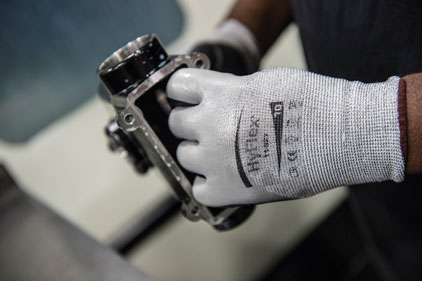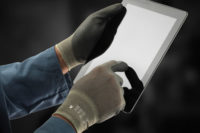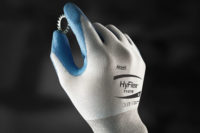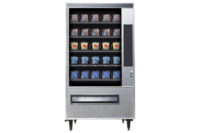This scenario is relatively common in body shops and plants where workers assemble engine and transmission drive trains, handle and assemble sharp components with oily coatings, and work in maintenance or metal press cutting and stamping operations. Oil is used in more than 60 percent of metal fabrication applications — to protect, shape, cut or work metal parts — with 88 percent of workers citing chemicals, oils and grease as their most frequent hazard.
In the past, hand protection products providing the necessary combination of oil repellence, grip and cut protection for the above applications were often scarce. New technology, however, helps protect worker hands against light to medium oily conditions while enhancing their ability to safely perform their jobs.
The importance of grip
It is simple physics: to securely grasp an object such as a metal piece, workers must have sufficient friction between the object and the hand. The object will slip and may fall if this friction is insufficient and the object does not have sufficient support from beneath. This situation is exacerbated in the presence of excessive moisture such as oils and lubricants.
Because workers want to maintain a safety margin when they grasp an object, they often predict how the object will behave and plan accordingly. If they believe the object has the potential to slip and fall, they will apply up to 40 percent more grip force than what they need to maintain a secure grasp. They will exert even greater grip force if the object is slippery because of lubricants or oils.
Applying excessive grip force for a period of time can lead to hand and arm fatigue, which impacts productivity. In the long term, it can result in musculoskeletal disorders such as carpal tunnel syndrome. Clearly, helping workers to avoid unnecessary grip force is a priority.
The case for oil repellence
In 2010, the U.S. Department of Labor’s Bureau of Labor Statistics reported 34,400 incidences of recordable skin diseases. Occupational skin diseases affect workers of all ages in a variety of work settings, including manufacturing, machine tool operations, printing, metal plating and engine service.
Oil transfers from the surface of parts workers are handling to penetrate the porous and absorbing components of knit work gloves as well as those made with leather, foam and other materials. Gloves that are impregnated or soaked with oil will show signs of significant mechanical degradation, which impacts worker safety and job performance.
In addition, human skin will readily absorb most chemicals without the worker even noticing, leading to skin diseases such as contact dermatitis and allergies. Occupational skin diseases are often difficult to treat because individuals who have a problem usually continue to work in the same conditions. Some occupational skin diseases may last 5 to 10 years, even forcing workers to change occupations.
Dermatologists continue to recommend that workers exposed to oil and other fluids wear chemical-resistant gloves made with appropriate compounds to protect the skin from contact. Some workers double-glove in an effort to protect the skin from irritation, wearing a single-use glove beneath a cut-resistant product when handling sharp objects in oily environments. While this solution protects the hands against irritants, double-gloving can create other challenges resulting from decreased dexterity, flexibility and comfort from excessive sweating.
New technology increases grip, repels oil
So, what can workers do when they need to maintain a firm grip on sharp objects in oily environments? New technology repels oil and other substances while allowing workers to apply less force to effectively grip wet or oily objects.
A ¾ nitrile dip primary layer enhances oil resistance and reduces the incidence of allergies and skin irritation. The ¾ dip coating meets the need for more protection across the back of the hand where gloves often become saturated with oil.
A secondary nitrile palm dip coating has a roughened surface comprised of microscopic channels that direct fluids away from the grip surface. Grip technology works similarly to tire treads cutting through water on a roadway, with the channels propelling oils and other lubricants away from the pressure surface.
What you have is a relatively dry contact area that allows workers to maintain almost the same grip in oily applications as they would experience under dry conditions. Improved grip is possible with a wide spectrum of viscosities, with the nitrile coating increasing product durability while improving worker safety.
During validation tests conducted at the University of Birmingham’s Behavioural Brain Sciences Centre in Birmingham, England, a steel shaft was lubricated with oil and workers wore gloves incorporating the oil repellency and grip technologies to determine their ability to grasp and lift the load in a predictable situation. Testing also examined their ability to grasp the load when it unexpectedly increased and when it slipped.
Workers wearing gloves incorporating the new technologies achieved a more secure grasp initially. They also maintained their grasp when the steel shaft’s weight unexpectedly increased. Testing showed the gripping surface enhanced workers’ ability to regain control of the lubricated shaft even when it slipped.
Cut protection
Many machining and assembly applications involve sharp edges and other cut hazards. Gloves incorporating oil repellent and grip technologies with a seamless nylon plaited high performance polyethylene knit liner will protect against cuts. The cut-resistant liner is an important element, reducing injuries as it increases worker confidence and productivity.
Work smarter, not harder
Changing and advanced processes in many plant facilities often result in workers facing multiple and varied on-the-job hazards. PPE manufacturers are responding by providing products that incorporate designs and technologies that reduce the risk of injury in a variety of environments.
New technologies such as those that protect against oil and increase grip and cut protection allow individuals to work more confidently and productively. As the old adage goes, employees are able to work smarter, not harder because they are comfortable without the fatigue that results from exertion.



